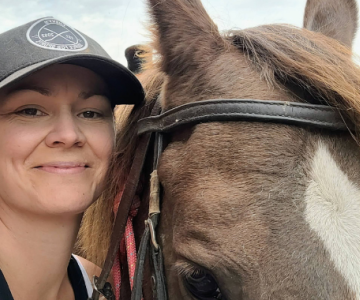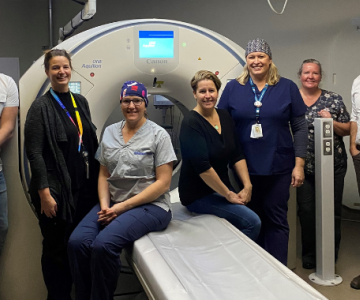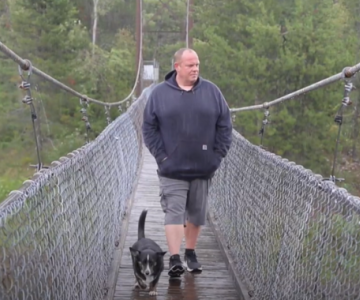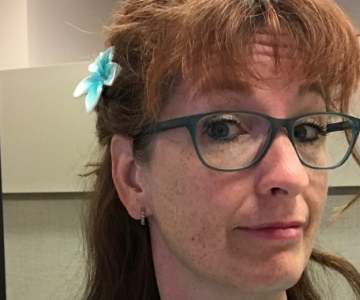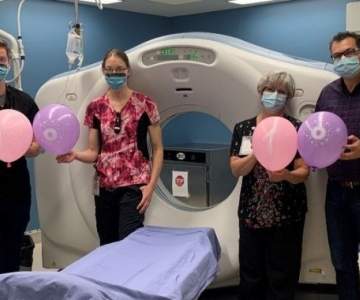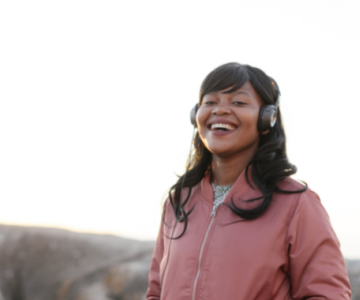Breadcrumb
Explore Stories
Community & Culture
We are IH is a recognition campaign to spotlight Interior Health employees and medical staff – through pictures and stories.
Name: Michaela Ashbee (she/her)
Job Title: Privacy Advisor
Years of Service: 7
Worksite: Community Health Services Centre
Community: Kelowna
Ancestral Territory: Syilx Okanagan
Favourite Quotes: “Everything happens for a reason.” - Anonymous
“Live life to the fullest!” - Anonymous
Michaela Ashbee has come a long way – literally – to her current role as a Privacy Advisor with Interior Health.
Born in a small town in (what was previously) East Germany, her family emigrated to Kelowna after her parents spent three amazing weeks in Canada to attend a family wedding and travel throughout B.C. Since 1993, Michaela has lived in Kelowna, not only attending school and university here, but also creating her own life and family.
“It was a big step for our family, but we’ve never looked back. We love not only living in this beautiful country, but also becoming Canadians!”
It wasn’t a straight path to her current role: Michaela spent seven years in the car industry in administration and accounting, then the beverage industry for eight years as administrator for the B.C. Interior. In 2015, she joined Interior Health as an Information Privacy Assistant, then moved to Information Privacy Analyst later that year. After going back to university and achieving her certification with the Canadian Institute of Access and Privacy Professionals (CIAPP), Michaela moved in to her current role.
Michaela enjoys helping people, seeing them succeed and achieving their goals. Those who work with her would not be surprised to hear Michaela describe herself as a passionate, dedicated go-getter who strives to exceed her goals. However, she also wears her heart on her sleeve and is a team player who loves to help others.
“I love being challenged and continuously learning new things. I don't do 'boring' well, which is the reason I like how fast-paced my current role is. Not only do I get to do what I love every day, but I work with such a diverse group of people and departments that keep sharing their knowledge and expertise with me and make every day an adventure!”
Michaela cannot pinpoint just one memorable aspect of her job. She’s had the opportunity to lead incident investigations for IH, as well as assist leaders with revamping processes and educating teams to help make IH a better, safer place.
The most recent big change for Michaela was leaving the Okanagan and relocating to the beautiful Kootenays, the traditional territory of the Ktunaxa Nation. Her family loves the outdoors so much that they’ve made the move from city life to country life.
If she’s not playing outdoors with her four big pups, enjoying horses, camping at a friend’s ranch, taking pictures or playing in the dirt while gardening, you can find Michaela at a hockey rink with her husband of 13 years, Brett, cheering on their 12-year-old son, Dominic, or local hockey teams. She also volunteers as a team manager and Grand Forks Minor Hockey Association Board Member.
A little-known fact is that in 2010, Michaela had the privilege of being an Olympic Torchbearer, running with the Olympic Torch in Kelowna.
Michaela was in a car accident in 2016, which resulted in a long term hip injury that’s limited the activities she’s able to do. But she’s pushed to find a new normal and always tries to live life to the fullest!
Michaela is looking forward to: “Enjoying every day, new adventures, new opportunities and getting to know my new community, and being a part of it to help it grow and thrive.”
Michaela's nomination keeps the We Are IH loop going:
“Paula Cyra is an amazing nurse, educator, mom, hockey billet mom and volunteer – and just has so much passion for helping others! Even her latest selfless venture of donating a kidney to a complete stranger is nothing short of amazing!" – Michaela Ashbee
Stay updated with careers at Interior Health
Facebook | Instagram | LinkedIn
Community & Culture
Across our region, local governments are supporting COVID-19 recovery and working hard to keep their communities safe.
Whether by encouraging people to get booster shots, or sharing information on how we can protect our communities from the new Omicron variant, municipal leaders bring a trusted, local voice to people in the community.
Two great examples are Armstrong Mayor Chris Pieper and Denis Delisle, an Area Director for Rural Enderby with the Regional District of North Okanagan. Both have been engaged, local champions promoting COVID-19 vaccination efforts in their communities.
Throughout the vaccine rollout in Armstrong, Pieper has directed city staff to advertise vaccination clinics in the community and through the city’s website and social media. He also visited a mobile vaccination clinic and shared his encouragement on Instagram to go get vaccinated!
“I fully support the COVID-19 vaccination program,” says Pieper. “It will help us return to some kind of new normal”. He also encouraged those who are hesitant about getting a vaccine to research trusted resources and “make a life saving decision to get vaccinated.”
Delisle continues to come up with innovative ideas for how to encourage Enderby residents to get vaccinated, and where additional drop-in vaccination clinics could be located.
“It’s clear to me that COVID-19 kills and injures people and its effect on people’s mental and economic well-being has been devastating,” says Delisle. “Please step up and get vaccinated. Do your part to keep our communities safe.”
Both Pieper and Delisle spoke on Global News to raise awareness of the low vaccination rates in their communities and encourage people to go get vaccinated.
"These local leaders in the North Okanagan have shown great leadership and care towards the safety and recovery of their communities, says Janelle Rimell with Interior Health's Healthy Communities, Healthy Families team.
"Thanks to all community leaders for your support and advocacy during these challenging times. Your efforts to promote trusted sources of COVID-19 information and encouraging community members to get vaccinated and to get booster shots will help our entire province fight this pandemic and deal with the new Omicron variant."
About the author
Janelle Rimell is an Environmental Health Officer with the Healthy Communities, Healthy Families team at Interior Health. This team works alongside local governments to create physical and social environments that support good health for everyone.
Health & Wellness
The language we use to talk about people with substance use disorders can bring out many negative stereotypes.
Substance use disorders are more highly stigmatized than any other health condition. This is largely due to the misinformed idea that addiction is a moral failing. Research shows that many people with substance use challenges have also experienced trauma, making them vulnerable and putting them at further risk of self-stigma by internalizing the negative messages they hear.
Stigma is a major barrier that prevents people from getting well. When we use stigmatizing language, we inadvertently block people from reaching out for help. This applies to the person with a substance use disorder, but also to their loved ones - stigmatizing language can have serious negative impacts on the family and friends of those with a substance use disorder, or those lost to overdose.
The shame caused by stigma also drives people to use alone, putting them at increased risk of harm.
Research about the impact of stigma shows that although people who use drugs alone understand the risks of a fatal overdose, the shame of coming forward and asking for help is
felt so strongly that they choose to hide their drug use.
Some people also feel stigma about carrying a naloxone kit. The stigma continues if a person is receiving methadone or Suboxone because their friends and loved ones may feel you are treating a drug with a drug.
Let's think about how the language we use might feel to someone living with a substance use disorder. Think about how your words would sound to a mother who just lost a child, or to someone grieving the loss of their best friend.
The toxic drug crisis continues.
In B.C. the 1,782 suspected illicit drug toxicity deaths between January and October 2021 are the highest ever recorded in a calendar year.
It's important that we reduce stigma around people who use drugs and ensure that everyone has access to the health-care services they need, where and when they need them.
You can make a difference!
Take the pledge online with Addiction Matters Kamloops to:
NOT use words or labels that are stigmatizing like addict, abuser, junkie or crack head.
Encourage others to use non-stigmatizing language and to understand the impacts of stigma on individuals and families impacted by substance use.
Use language that is compassionate and respectful when discussing addiction or someone who uses substances.
Think of the individual as a person, and not define them by their illness.
Community & Culture
Henry Ford once said: “Coming together is a beginning; keeping together is progress; working together is success.”
Interior Health and the Shuswap Hospital Foundation have been coming together, keeping together, and working together for many years, to the benefit of a quality care experience for people in the Salmon Arm area.
The latest example of this successful partnership comes through the investment of a new $2 million CT scanner, which was recently installed in Shuswap Lake General Hospital’s medical imaging department. It’s a replacement machine for the hospital’s old CT scanner, which also came courtesy the Foundation a dozen years ago, and it’s going to allow people in the region greater access to scans than they had previously – which will keep their care closer to home.
“I truly am blessed by the relationship we have with the Foundation,” says Kim Mead, professional practice lead in the SLGH imaging department. “The Foundation has always supported the Imaging Department with generosity. I know that when I need something, I can go to them and they accept the challenge graciously. And they come through for us.”
The new CT scanner is a top-of-the-line model that produces high-quality, multiple-image sets faster and with less radiation dose, rather than the single picture provided by the previous machine. As well, a wide field detector allows the scanner to capture the entire heart in a single rotation, in .2 of a second, says Kim.
To the non-professional, all of that tech talk may not mean much. But if, for example, you’re a person having a stroke, the new CT scanner allows the SLGH health care team to diagnose and either treat you right in Salmon Arm, or initiate an immediate transfer to Kelowna for clot-removal surgery, if required.
And that’s exciting for the care teams at SLGH. They expect it to be a busy machine – the original model performed 96,468 scans over the 12-year period it was in service.
Dr. Aron Zuidhof, medical director for the IH Emergency Services Network, says the new scanner will allow emergency department physicians the ability to diagnose and treat a variety of ailments, including stroke, trauma, kidney stones, gout, blood clots in lungs, abdominal issues, and COVID-19. And, it will do so with the ability to “dial down to minimal doses” of radiation, which is particularly important in young children whose bodies are more susceptible to its harms.
“It hugely improves our ability to provide care,” Dr. Zuidhof says. “Having the CT and having Foundation support is a huge bonus for us.”
The bonuses aren’t all in patient care, either. Having top-quality equipment is also a draw for other health-care professionals to the region. When installed in 2009, the original CT scanner operated with just one staff member, Monday to Friday from 8 a.m. to 4 p.m. Now, the medical imaging department has five radiologists, five full-time imaging employees and operates 24-7.
“The generosity of our community continues to assist in advancing the quality of patient care and quality of life here in the Shuswap. The Shuswap Hospital Foundation is proud to be able to support these significant improvements to our health-care facilities,” says Angie Spencer, Foundation board president.
It’s no wonder there’s excitement in the air around the new CT scanner, as well as around another Foundation project that will result in a new $2 million mammography x-ray machine being installed at SLGH in fall 2022. The new equipment will mean breast tissue can be scanned and lumpectomies performed locally, if necessary – providing another service that patients can receive without having to travel to another community.
Photo above: the medical imaging team at Shuswap Lake General Hospital with their new CT scanner
This story is part of a series called Partners Make Us Better. Through these stories, we acknowledge and celebrate the important contributions of our partners in creating a quality, person-centred health-care experience.
Health & Wellness
Matthew first realized he needed help with his alcohol use during his late 20s. He was drinking daily, he says, and recognized that he was using alcohol as a way to bury problems in his life.
Community & Culture
We are IH is a recognition campaign to spotlight Interior Health employees and medical staff – through pictures and stories.
Name: Carol Kay (she/her/hers)
Job Title: Document Analyst Clerk
Years of Service: 17
Worksite: Royal Inland Hospital
Community: Kamloops
Current Territory: Tk’emlúps te Secwe̓pemc
Ancestral Territory: Moffat Scotland & Tipperary Ireland
Favourite Quote: Where there's is a will, there's a way.
The ability to have a diverse and rewarding career over 17 years at Interior Health is a source of pride for Carol Kay.
She started her journey as a Licensed Practical Nurse, working for seven years at Royal Inland Hospital and three years at Ponderosa Lodge in Kamloops, while balancing life with two crazy and fun-loving daughters.
She then shifted to a role in administration for the Parkview Child & Adolescent Mental Health Program, where she worked for five years. In 2018, she accepted her current position – Document Analyst Clerk with IH’s Document Services department.
“One of my proudest moments at Interior Health was being a part of the growth of the Parkview Child & Adolescent Mental Health Program, working with the psychiatrists and staff. This had a significant impact for the betterment of children and youth in our community.
“Also, being acknowledged for my services and commitment to working with a great organization and staff, while receiving my long-term service 15 year pin.”
Today, Carol enjoys assisting IH staff with Document Services-managed forms and updating the Forms Repository and Forms Library, which uses her penchant for organizational skills and fine data entry.
What you might not know about Carol’s history is that, in her younger years, she was a cadet in the #102 Navy League of Canada Prince Robert Cadet Corps Kamloops, and then #137 Royal Canadian Sea Cadet Corp Kamloops as a teenager. This is where Carol learned her strong leadership skills, participated in countless citizenship activities, and developed a love for the Canadian Armed Forces. This led her to find her passion developing our future leaders of Canada in the Canadian Armed Forces, as a Second Lieutenant (2LT) in Cadet Instructor Cadre (CIC) Program in the towns of Golden and Cranbrook, B.C.
Carol Kay, when she first joined Navy League Cadets (left), and in her Canadian Armed Forces uniform.
Carol is currently an active member of Army, Navy and Air Force Veterans, Unit #290 North Kamloops (ANAVETS), generating camaraderie amongst fellow veterans and members by displaying her spirit of patriotism for Canada. Carol has also shared her time with the Royal Canadian Legion for the past 20 years, where she continues to bring her positive leadership and passion. Today, you can find her being a Veteran's Advocate and preserving Canadian Military history and traditions for her country. Carol is always ready to serve when called upon, even for the smallest undertaking.
When not at work, Carol shows her pride in her Celtic heritage as she continues to grow with the Kamloops Pipe Band Society as a side drummer. Carol also enjoys a healthy active lifestyle with swimming and has a passion for gardening.
Carol’s Pipe Band played for Royal Inland Hospital staff in appreciation of health-care workers during the pandemic.
To keep We Are IH going, Carol nominates Kailey Auger, Program and Systems Analyst with IMIT.
“Kailey has the wonderful ability to adapt to a fast-paced environment. Kailey continues to bring her exemplary standards of teamwork, while developing new staff to reach their full potential by working together respectfully and growing as a team. Kailey has an unforgettable laugh and passion for her colleagues. Like many in our organization, Kailey gained a deeper understanding of her current position by her learned experiences during her career at IH. Kailey is a valuable asset as a colleague and mentor. She is always striving to have a better understanding of her career and a respectful relationship with others.”
Stay updated with careers at Interior Health
Facebook: Interior Health | Instagram: interiorhealthbc
| LinkedIn: Interior Health Authority
Community & Culture
Mary Larsen enjoys decorating her workplace, David Lloyd Jones care home, for the holidays.
We are IH is a recognition campaign to spotlight Interior Health employees and medical staff – through pictures and stories.
Name: Mary Larsen (she/her)
Job Title: Recreation Assistant
Years of Service: 4.5
Worksite: David Lloyd Jones care home
Community: Kelowna
Ancestral Territory: Syilx Okanagan
Favourite Quote: “Treat everyone as if it is the last time you will see them.” -Anonymous
When it comes to the holidays, Mary Larsen is the quintessential “Santa’s elf.” A recreation assistant at the David Lloyd Jones care home, seeing the residents and creating programming for them brings Mary joy every day.
“Seeing the residents engage in an activity and say that it was a good time is so wonderful. Knowing that I get to come to work and give people moments of joy is why I do what I do!”
Mary dressed up for the holidays.
While Mary has many proud moments as a staff member at Interior Health, one of her favourites is working with new students training to be therapist assistants. She appreciates being able to show the students the importance of recreation in a long-term care setting and how much of an impact it has on the people in IH’s care.
While rewarding, Mary’s job can also be mentally and emotionally hard at times. Many assume she’s an “extrovert” because of her job, but Mary craves being alone or just with her close family. She also finds herself in nature to recharge.
“When I have time to go for a hike or sit by a lake and let nature take care of me, I feel better. I love hiking with my dog. Being with her and exploring parts of the Okanagan is so much fun!”
Mary loves exploring the Okanagan with her dog, Rose.
Born and raised in B.C., Mary moved from New Westminster to the Kootenays, and then settled in the Okanagan more than 20 years ago. She enjoys cross-country skiing with her husband, Erik, daughter, Rory, and dog, Rose.
“We bought skis for the family and I cannot wait to get out to the trails and be in nature!”
Mary is looking forward to when families are once again able to join in the recreation programs at David Lloyd Jones. A little-known fact is that, when she signed up for the Therapist Assistant program with Okanagan College, Mary had no idea she’d end up with her dream career in long-term care.
“I never in a million years thought that I would end up in health care! I had no idea of the opportunities that lie within Interior Health. Now I could not imagine doing anything else with my life!”
Mary’s nomination keeps the We Are IH loop going:
“Riley Wilkinson is an amazing advocate for her patients. She is kind and generous, and absolutely dedicated to giving her patients the best care.” – Mary Larsen
Stay updated with careers at Interior Health
Facebook | Instagram | LinkedIn
Research & Innovation
Thanks to fundraising efforts of the Kootenay Lake Hospital Foundation, ten years ago the hospital in Nelson started providing CT exams as part of their health-care services. And they’ve never looked back.
In the first year of service, 2,300 CT exams were performed. Ten years later, the number of exams has doubled to more than 5,000 exams done annually.
CT, or computerized tomography, is a type of medical scan that helps diagnose appendicitis, cancer, stroke, trauma, chest infections and many other conditions that require more detailed images than a regular x-ray can provide. They also play an important role in cancer care and emergency medicine.
"I am so thankful to the forward thinkers who fought for the addition of a CT to our hospital and prepared our facility to deliver a consistently excellent standard of medical care," said Dr. James Wiedrick, chief of staff at the hospital. "I cannot imagine practicing emergency medicine in 2021 without an on-site CT scanner."
After 18 months of fundraising, the Kootenay Lake Hospital Foundation raised almost $1.5 million to help bring this critical service to Nelson.
“Everyone in the community was involved in one way or another. Whether it was buying raffle tickets, collecting bottles, donating jars of pennies and birthday money. The entire community really came together in a way I’ve never seen before,” said Bryna Idler, executive director of the Foundation.
Not only has the number of exams increased over the years, but residents are able to have more complex procedures done closer to home thanks to the addition of medical staff like radiologist Dr. Dave Williams.
To learn more about this type of medical scan, check out the CT scans service listing page on www.InteriorHealth.ca
Pictured above: CT Techs Matt Brind’Amour and Tineke Reese, Deb Creaser (Medical Imaging Manager), Dr. Dave Williams (Radiologist)
Health & Wellness
Podcasts about mental wellness are a great way to relax, learn something new, and find inspiration, all in a convenient and entertaining package. They are especially helpful during the dark cold days of winter when we can all use a lift.
There are also an increasing number of wellness-focused Apps available.
But the sheer number of these podcasts and Apps can make choosing overwhelming. There are thousands. Where to start?
We asked our Mental Health and Substance Use team for some recommendations. Here are their Staff Picks:
Podcasts:
Unlocking Us: Researcher, speaker and best-selling author Brené Brown discusses the “universal experiences of being human, from the bravest moments to the most broken-hearted.”
10% Happier: Journalist Dan Harris delves into meditation, anxiety, relationships and productivity.
Feel Better. Live More: Dr. Rangan Chatterjee aims to simplify health and provides tools and tips to live a more balanced and health-focused life.
Sickboy: Sickboy co-hosts interview guests who share firsthand stories, often speaking openly and frankly about death, disease, disability, and other topics that deserve to be highlighted instead of hidden in the shadows.
Conan O’Brien Needs a Friend: Famous late-night host Conan O’Brien is hilarious. But he is also lonely. Listen in as he delves into intimate conversations and makes real connections.
Reminder, if you have sensitive ears or children nearby, pay attention if there is an “E” beside the podcast episode listing - it means explicit language.
Wellness Apps:
Headspace: Headspace provides meditation and mindfulness tools to help develop habits that support positive mental health.
Tide: With options around improved sleep and focus, as well as guided meditation and breathing, Tide is “a massage for your brain” using nature sounds and other techniques.
Calm: This App offers meditations, visualizations, guided breathing and sleep stories, designed to help you relax and rest.
Don’t forget we have our own podcast. Check out Interior Voices, which explores Aboriginal health and culture.
Happy listening!
*Download and/or subscription fees may apply.
-
Load More
Showing 522 of 786
Sign up for email updates
Receive news, alerts, public service announcements and articles right to your inbox.


